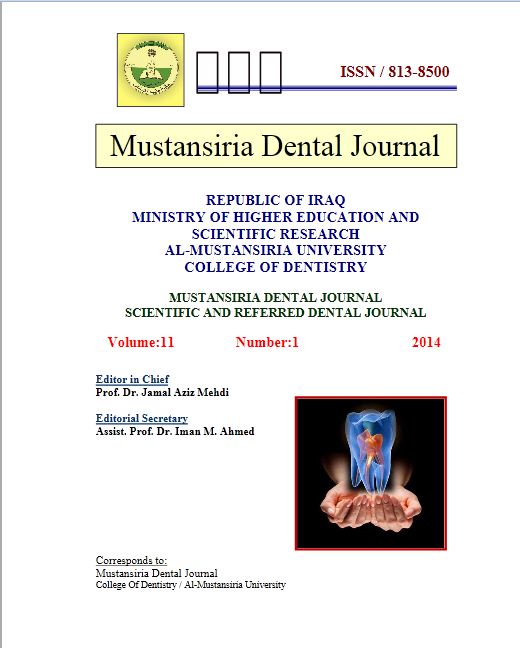Measuring and comparing the shear bond strength of acrylic resin veneer to nickel –chromium alloy after different metal surface treatments
DOI:
https://doi.org/10.32828/mdj.v11i1.161Abstract
The bond strength of metal-resin interface of prosthesis is a key factor in
determining the serviceability of that prosthesis. The main objective of this study was
to determine the effect of different surface treatment on the shear bond strength of Ni-
Cr alloy (CB-Blando 72 alloy) and heat cured acrylic veneer resin (Ivoclar Co.).One
hundred twenty eight disc shaped samples from base plate wax were prepared, the
diameter of disc was (8mm×4.5mm).After casting the metal, the samples were
cleaned, finished, and polished by silicon carbide abrasive paper with a grit size
(600μm), and then the profilometer was used to determine the surface roughness of
the samples (Ra) which ranged between (0.09-0.13μm). Then the samples were
divided into 2 categories ,each category contain (64)samples which also were
subdivided into 8 group ,the first category include (A, B, C, D, E, F, G, H) and the
second category include (At, Bt, Ct, Dt, Et, Ft, Gt, Ht), according to the metal surface
treatment which include :
Group A, At: Received no treatment and serve as control.
Group B, Bt: Received chemical treatment using chemical bonding agent (Metal
primer II).
Group C, Ct: Received micromechanical treatment using air abrasion with 50μm
Al2O3.
Group D, Dt: Received micromechanical treatment using air abrasion with 50μm
Al2O3 +metal primer II
Group E, Et : Received micromechanical treatment using air abrasion with
110μmAl2O3.
Group F, Ft: Received micromechanical / chemical treatment using (air
Abrasion110μm Al2O3 + metal primer II application).
Group G ,Gt: Received micromechanical treatment using air abrasion 250μm Al2O3.
Group H, Ht: Received micromechanical /chemical treatment using (air abrasion
250μm Al2O3 +metal primer II).
The acrylic was then prepared as round shape (8mm in diameter and 2mm in
thickness) that was placed on the metal surface treatment; the acrylic was fabricated in
the same conventional way for construction veneer resin.
For the specimens in the first category, the specimens were tested under dry
condition, while in the second category; the specimens were tested after (24) hoursstorage in water room temperature (37˚C) and (1000 time) thermocycling. The shear
bond strength was tested in instron universal testing machine.
The results before and after thermocycling showed that the air abrasion with
50μm Al2O3 plus metal primer II group gave the highest shear bond values, followed
by air abrasion with 110μm Al2O3 plus metal primer II, followed by air abrasion with
50μm Al2O3, followed by air abrasion with 250μm Al2O3 plus metal primer II,
followed by air abrasion with 110μm Al2O3, followed by air abrasion with 250μm,
followed by metal primer II group, and followed by untreated group.
Also after thermocycling showead that the micromechanical/chemical treatment
(air abrasion with Al2O3+metal primer II) gave the highest and more durable shear
bond strength values than other groups

Downloads
Published
Issue
Section
License
The Journal of Mustansiria Dental Journal is an open-access journal that all contents are free of charge. Articles of this journal are licensed under the terms of the Creative Commons Attribution International Public License CC-BY 4.0 (https://creativecommons.org/licenses/by/4.0/legalcode) that licensees are unrestrictly allowed to search, download, share, distribute, print, or link to the full texts of the articles, crawl them for indexing and reproduce any medium of the articles provided that they give the author(s) proper credits (citation). The journal allows the author(s) to retain the copyright of their published article.
Creative Commons-Attribution (BY)








